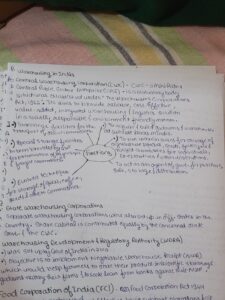Analyze the policy and investment goals in this area and discuss the role that agri-logistics infrastructure—such as cold storage facilities, transportation networks, and warehousing—plays in lowering post-harvest losses and improving farmers’ access to markets.
Impact of the Shift Towards High-Value, Water-Intensive Crops on Water Use Efficiency and Irrigation Sustainability The shift towards cultivating high-value, water-intensive crops like fruits and vegetables has significant implications for water use efficiency and the sustainability of irrigation syRead more
Impact of the Shift Towards High-Value, Water-Intensive Crops on Water Use Efficiency and Irrigation Sustainability
The shift towards cultivating high-value, water-intensive crops like fruits and vegetables has significant implications for water use efficiency and the sustainability of irrigation systems in India. While these crops can offer substantial economic benefits, they also pose challenges related to water resource management. Analyzing these impacts and discussing necessary policy interventions can help in achieving a balance between economic gains and sustainable water management.
1. Impact on Water Use Efficiency
a. Increased Water Demand: High-value crops such as fruits and vegetables generally require more water compared to traditional cereals:
- Water Consumption: These crops often have higher water needs, which can lead to increased overall water consumption. For example:
- Horticultural Crops: Growing crops like mangoes, grapes, and cucumbers typically demands more irrigation compared to staple crops like wheat or rice, putting additional pressure on water resources.
b. Efficiency of Water Use: While these crops are water-intensive, they often benefit from modern irrigation techniques that can enhance water use efficiency:
- Drip and Sprinkler Irrigation: Advanced irrigation methods such as drip and sprinkler systems are used to optimize water use for high-value crops. For instance:
- Maharashtra’s Drip Irrigation in Grapes: In Nashik, drip irrigation has been successfully employed in grape cultivation to reduce water usage while improving yields.
2. Impact on Irrigation Systems and Sustainability
a. Pressure on Water Resources: The increased cultivation of water-intensive crops can strain existing irrigation systems and water resources:
- Groundwater Depletion: Overreliance on groundwater for high-value crops can lead to depletion of aquifers. For example:
- Punjab and Haryana: Intensive cultivation of water-intensive crops in these regions has resulted in significant groundwater depletion, raising concerns about long-term water sustainability.
b. Sustainability of Irrigation Infrastructure: The shift towards these crops can challenge the sustainability of traditional irrigation infrastructure:
- Infrastructure Strain: Traditional irrigation systems may not be designed to handle the demands of high-value crops, leading to inefficiencies and infrastructure stress. For instance:
- Tank Irrigation Systems: In southern India, traditional tank irrigation systems may struggle to meet the increased water demands of high-value crops, affecting their overall sustainability.
3. Policy Interventions to Promote Crop Diversification and Sustainable Water Management
a. Promoting Crop Diversification: Encouraging a diverse range of crops can help reduce pressure on water resources:
- Diversification Incentives: Policies that promote the cultivation of a mix of crops, including drought-resistant varieties, can improve water use efficiency. For example:
- National Mission for Sustainable Agriculture (NMSA): This mission supports crop diversification and sustainable agricultural practices, including the use of drought-resistant crops.
b. Enhancing Water Efficiency: Investing in technologies and practices that enhance water use efficiency is critical:
- Advanced Irrigation Techniques: Promoting the adoption of efficient irrigation systems like drip and sprinkler irrigation for all crop types. For example:
- Subsidy Programs: Government subsidy schemes, such as those for installing drip irrigation systems in horticulture, help improve water use efficiency.
c. Supporting Research and Development: Investing in research to develop water-efficient crop varieties and technologies:
- Research Initiatives: Supporting research to develop crops that require less water and are resilient to climate variability. For instance:
- ICAR Research: The Indian Council of Agricultural Research (ICAR) is involved in developing water-efficient crop varieties and technologies to enhance sustainability.
d. Improving Water Resource Management: Implementing comprehensive water resource management practices to ensure sustainable use:
- Integrated Water Management: Adopting integrated water resource management (IWRM) practices to balance water allocation between different crop types. For example:
- River Basin Management: Programs like the National River Conservation Plan work towards integrated management of river basins, which can improve water distribution and usage efficiency.
e. Policy and Regulatory Framework: Establishing policies and regulations that promote sustainable agricultural practices:
- Water Use Regulations: Implementing regulations that limit excessive water use for high-value crops and encourage sustainable practices. For instance:
- Groundwater Regulation: States like Rajasthan have introduced regulations on groundwater extraction to manage water use for high-value crops more sustainably.
f. Farmer Education and Training: Providing education and training to farmers on sustainable practices and efficient water use:
- Training Programs: Conducting training programs to educate farmers on the benefits of crop diversification and efficient water management practices. For example:
- Kisan Call Centers and Training Programs: Initiatives under the Soil Health Management Scheme provide farmers with information on sustainable practices and efficient water use.
Conclusion
The shift towards high-value, water-intensive crops presents both opportunities and challenges for water use efficiency and the sustainability of irrigation systems in India. While these crops can offer significant economic benefits, they also place additional demands on water resources and infrastructure. Addressing these challenges through crop diversification, enhanced water efficiency, research and development, and supportive policies is crucial for ensuring sustainable water management and agricultural productivity. By implementing targeted policy interventions and investing in sustainable practices, India can better balance economic growth with environmental sustainability.
See less






See less